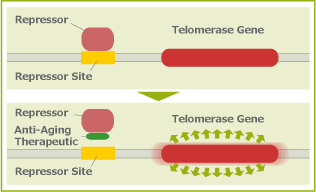Home > R & D
Research and Development
About “Telomere”
Telomeres are structures at the end of our chromosomes that shorten every time a human cell divides. Each time our cells divide and our chromosomes replicate, our telomeres become shorter. They shorten throughout our lifetime, and when they reach an average of about 5,000 nucleotides, our cells cannot divide any further, and we die of old age.
This problem is because of a telomerase enzyme deficiency syndrome, or TEDS that affects every one of us. If it weren’t for lack of this enzyme our telomeres stay long and healthy. The length of an individual's telomeres is closely associated with their biological age and research suggests that control of telomere length has the potential to treat many diseases associated with aging.
Only in the last thirty years science has made real progress in understanding the fundamental question of why we age and what can be done about it. These discoveries have not been widely publicized-‐yet -‐ and so most people are unaware of how close we are to curing the disease of aging once and for all.
Cause of aging “Telomere”

However, telomeres is required for normal chromosome segregation, since thereby shortening the time a cell divides, the telomeres become shorter than a certain length, cell viability occurs destabilization of chromosomal loss, as a result, it will appear a variety of aging of the body.
In other words, the telomere is related to the fundamental factors of human aging.
Diseases caused by telomere shortening
| Disease name | abbreviation |
|---|---|
| CVD | |
| - | |
| COPD | |
| DDD | |
| AD | |
| OA | |
| RA | |
| - | |
| - | |
| - | |
| AMD | |
| - | |
| - | |
| - | |
| AIDS | |
| HGPS | |
| DC | |
| IPF | |
| - | |
| DS | |
| FA | |
| TS | |
| - | |
| - |
The key of life-span “Telomerase”
Nobel Prize in Physiology or Medicine in 2009, California University of Elizabeth Blackburn (Elizabeth Blackburn), Professor, Johns Hopkins University Carol grader (Carol W. Greider) Professor, Harvard University Jack Zosutakku (Jack W. Szostak ) 3 Mr. professor has been awarded.
Winning reason was the "discovery of the mechanism of telomere and telomerase enzyme, which holds the key to life."
"Telomerase" is the enzyme to extend the specific repeated sequences of telomere present in the chromosome ends of eukaryotic organisms.
However, in humans, and activity was observed in such germ cells, stem cells and cancer cells, and the other of telomerase activity is not seen almost.
Therefore, "the extension of the cell division life" by increasing the activity, in to suppress the activity has attracted attention both in terms such as "cancer treatment"
“TAM-818” – Bill Andrews,Ph.D’s greatest invention and related theories

“TAM-818,” developed by Bill Andrews,Ph.D. (Sierra Sciences, LLC.) in 2014, is a state-of-the-art substance that prevents telomere shortening.
We began research in 1999, and after investigating nearly 60,000 chemical substances, we finally discovered the first chemical substance with medicinal properties in 2007.
(*The patent and product rights for this drug were transferred to the American company T. A. Sciences, and it was introduced into the market as “TA-65” in 2007.)
Testing continued, and after nearly 400,000 tests, we discovered C0314818. We have scientifically verified the mechanism of this substance and have obtained a patent. This substance is “Telomerase Activation Molecule 818 (TAM-818),” a molecule that guides and activates telomerase. In fact, comparison tests between “TAM-818” and “TA-65” have shown that the telomere lengthening effect of “TAM-818” is 80 ~ 300 times that of “TA-65.”
| Fortunately, the telomerase gene already exists in all our cells. That’s because the DNA in every one of our cells is identical: a skin cell, muscle cell, and liver cell all contain exactly the same genetic information. Thus, if the cells that create our sperm and egg cells contain the code for telomerase, every other cell must contain that code as well. |
|---|
|
The reason that most of our cells don’t express telomerase is that the gene is repressed in them. There are one or more regions of DNA neighboring the telomerase gene that serve as binding sites for a protein, and, if that protein is bound to them, telomerase will not be created by the cell. however, it is possible to coax that repressor protein off its binding site with the use of a small-molecule, drug-like compound that binds to the repressor and prevents it from attaching to the DNA. If we find the appropriate compound, we can turn telomerase on in every cell in the human body. |
|---|






